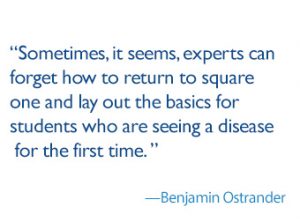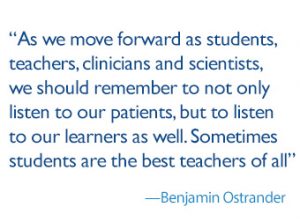Traditionally, medical school is viewed as a continuous four-year educational experience. In reality, the structure of medical education is that of contrasting, dichotomous learning methodologies divided into two sequential stages: preclinical and clinical years. The daily lifestyles, schedules and learning styles of medical students within these two distinct but complementary components of medical school could not be more different, and the transition between them is a time of excitement, anxiety and realization.
 Before this momentous transition, students learn predominantly from lectures accompanied by slides in the classroom. This is supplemented by small-group learning activities. At the Johns Hopkins University School of Medicine, we have the privilege of having teachers who are expert clinicians and often leaders in their fields. With this expertise comes the complexity and attention to detail that is expected from an individual who has dedicated his or her life to understanding a specific topic or disease. Many of our professors are fantastic at conveying this complexity with skill and thoughtfulness. Yet occasionally, the details are lost on medical students, who seek a broader introductory view of a topic and a foundation from which to build upon. Sometimes, it seems, experts can forget how to return to square one and lay out the basics for students who are seeing a disease for the first time. Learners require a strong overarching framework and a grasp of the vocabulary before grappling with intricacies.
Before this momentous transition, students learn predominantly from lectures accompanied by slides in the classroom. This is supplemented by small-group learning activities. At the Johns Hopkins University School of Medicine, we have the privilege of having teachers who are expert clinicians and often leaders in their fields. With this expertise comes the complexity and attention to detail that is expected from an individual who has dedicated his or her life to understanding a specific topic or disease. Many of our professors are fantastic at conveying this complexity with skill and thoughtfulness. Yet occasionally, the details are lost on medical students, who seek a broader introductory view of a topic and a foundation from which to build upon. Sometimes, it seems, experts can forget how to return to square one and lay out the basics for students who are seeing a disease for the first time. Learners require a strong overarching framework and a grasp of the vocabulary before grappling with intricacies.
Paradoxically, teaching prowess is not something that is required to become a medical professor. The academic hierarchy in medicine is formed by clinical skill, academic productivity and scientific accomplishment. Master clinicians may be genius diagnosticians and empathic caretakers, but this does not also guarantee they will be great teachers. To muddy the waters even further, teaching is not something that is well-compensated or highly rewarded in academic medicine. Teaching takes time and effort, and does not generate revenue. Finally, the best clinicians and most highly respected teachers are most often promoted to administrative roles, where they have significantly less time to see patients and teach the next generation.
A New Model of Teaching Recognition
Fortunately, there are a number of forces countering these issues with the structure of medical education. Last spring, the Distinguished Teaching Society of the Johns Hopkins University School of Medicine inducted its first group of master educators. This is a student-led initiative aimed at creating a new model of teaching recognition based on student nominations, and it has been extremely well-received by faculty and students alike. This year’s inductees were announced at the beginning of March.
Peer-to-Peer Training and Resources
Another essential component of preclinical education involves peer-to-peer teaching. A common thread within the restructuring of medical education is that it is frequently student-driven. In fact, some of students’ favorite educational tools have been created by other students. When medical student Sam Roman went through the Genes to Society (GTS) curriculum, she meticulously typed notes from every single lecture and slide deck, paring down the curriculum to a no-nonsense, bullet-pointed summary of the most essential facts. She chose to share this resource with her fellow classmates, and now her famous “Roman Notes” have been used by hundreds of students.
“I really never thought [my personal notes] would reach an almost-legendary popularity with the classes to follow,” Roman now recalls. “I really think students appreciate the format for the same reasons I made them for myself — we have lots of competing interests and short attention spans, and the notes contain the important information with helpful graphics in an aesthetically pleasing way.”
 Another student, Divine-Favour Anene, started to compile slides and give review lectures to first-year students prior to each exam during his second year of medical school at Johns Hopkins. When asked about his motivation to create these lectures, Divine says he has “always loved teaching and seeing other people succeed,” and wanted to “provide a different ‘student perspective’ on content in the preclinical years.” As a current student, he has an intimate understanding of what topics are important, how they can be easily conveyed in the most fundamental and simple way, and what knowledge will be tested not only during GTS, but also on standardized exams, like the United States Medical Licensing Examination. This firsthand knowledge is something unique that a subspecialized clinical expert 30 years out of medical school often does not possess.
Another student, Divine-Favour Anene, started to compile slides and give review lectures to first-year students prior to each exam during his second year of medical school at Johns Hopkins. When asked about his motivation to create these lectures, Divine says he has “always loved teaching and seeing other people succeed,” and wanted to “provide a different ‘student perspective’ on content in the preclinical years.” As a current student, he has an intimate understanding of what topics are important, how they can be easily conveyed in the most fundamental and simple way, and what knowledge will be tested not only during GTS, but also on standardized exams, like the United States Medical Licensing Examination. This firsthand knowledge is something unique that a subspecialized clinical expert 30 years out of medical school often does not possess.
One of my favorite parts about the Johns Hopkins community is the way in which driven colleagues collaborate, teach, learn and push each other to be the best they can be. As we move forward as students, teachers, clinicians and scientists, we should remember to not only listen to our patients, but to listen to our learners as well. Sometimes students are the best teachers of all.
Want to read more from the Johns Hopkins School of Medicine? Subscribe to the Biomedical Odyssey blog and receive new posts directly in your inbox.
Related Content
- Students develop a new track at Johns Hopkins School of Medicine: Training Future Leaders in Primary Care.
- Learn more about the Genes to Society curriculum available through The Johns Hopkins University School of Medicine.
- Johns Hopkins Offers Training Flexibility Through Its M.D./M.B.A. Program
- Johns Hopkins Teaching Academy Shapes Future Faculty Members
- Summer Teaching Institute Helps Students Prepare for Academia
